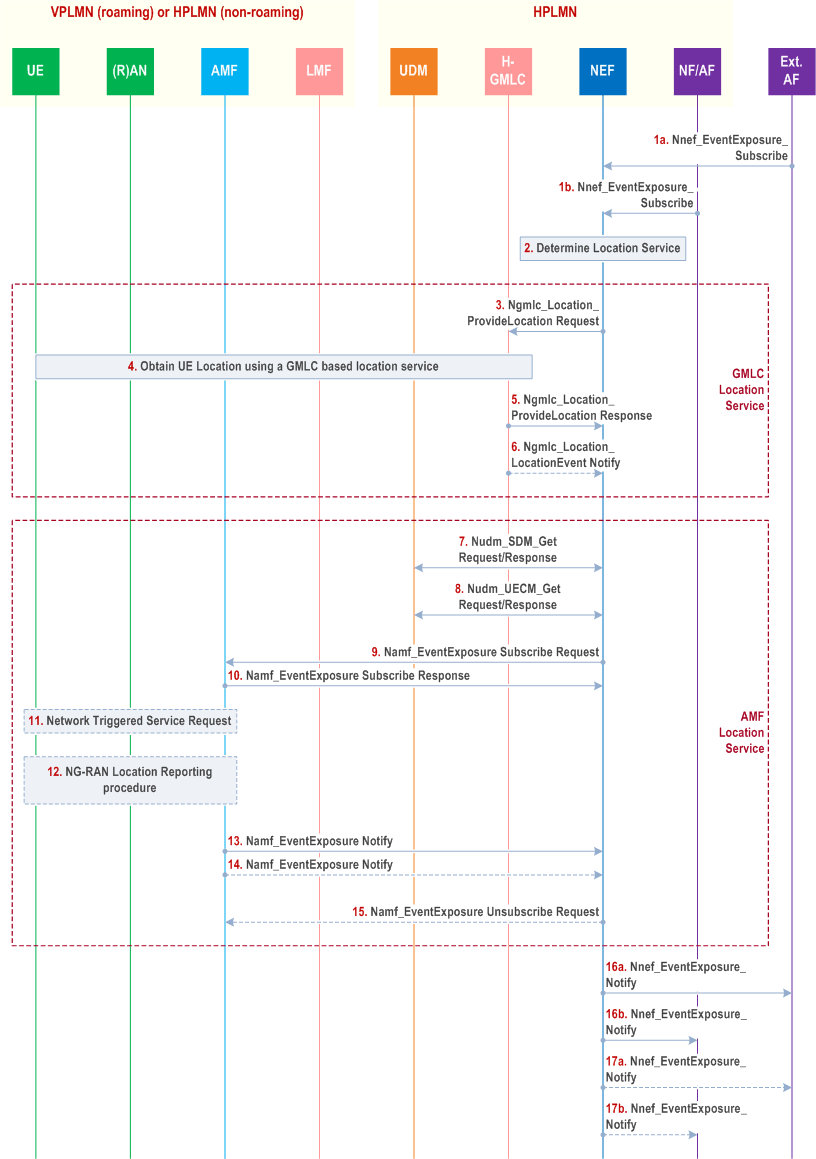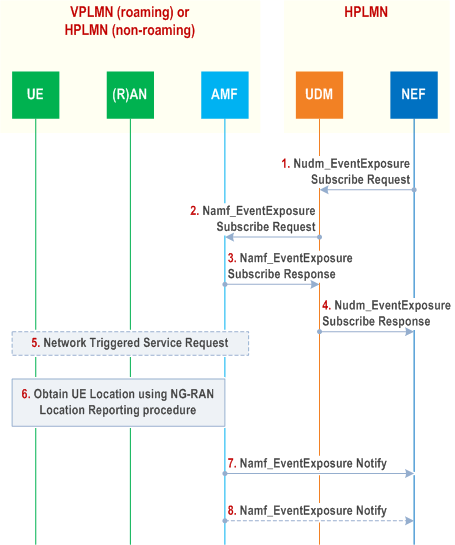Content for TS 23.273 Word version: 19.1.0
1…
4…
4.2…
4.2a…
4.3…
5…
5.5…
6…
6.1.2
6.1.3
6.1.4…
6.2
6.3…
6.3.2…
6.4
6.5…
6.7…
6.7.3
6.7.4
6.7.5
6.8
6.9…
6.10…
6.11…
6.12…
6.13…
6.14…
6.15…
6.16…
6.17…
6.18…
6.19…
6.19.2…
6.20…
6.20.4…
6.21…
7…
8…
A…
B…
C…
6.5 Unified Location Service Exposure Procedure
6.5.1 Unified Location Service Exposure Procedure without routing by a UDM
6.5.2 Unified Location Service Exposure Procedure with routing via a UDM
6.6 NG-RAN Location Service Exposure Procedure
...
...
6.5 Unified Location Service Exposure Procedure p. 80
6.5.1 Unified Location Service Exposure Procedure without routing by a UDM p. 80
Figure 6.5.1-1 shows a unified location service exposure procedure provided by an NEF in an HPLMN for a target UE to an NF in the HPLMN or to an external AF outside the HPLMN. The procedure enables a request for an immediate location or for a deferred location for a target UE.

Step 1a.
Step 1b.
Step 2.
Step 3.
Step 4.
Step 5.
Step 6.
Step 7.
Step 8.
Step 9.
Step 10.
Step 11.
Step 12.
Step 13.
Step 14.
Step 15.
Step 16a, 16b.
Step 17a, 17b.
An external AF invokes an Nnef_EventExposure_Subscribe service operation towards an NEF in the HPLMN for a target UE and includes an identification of the UE (e.g. SUPI or GPSI) and details of the location request such as whether a current or last know immediate location or a deferred location is requested, the location accuracy and response time, maximum age of location, LDR request information and other information applicable to the type of request.
Step 1b.
As an alternative to step 1a, a consumer NF in the HPLMN for a target UE invokes an Nnef_EventExposure_Subscribe service operation towards an NEF in the HPLMN and includes a global identification of the UE (e.g. SUPI or GPSI) and details of the location request as in step 1a.
Step 2.
Based on the service requirements in step 1a or step 1b (e.g. location QoS and whether an immediate or deferred location is requested) and on the availability of GMLC versus AMF based location service, the NEF determines whether the location request in step 1a or step 1b can be mapped to a GMLC based location service or to an AMF location event exposure service. The NEF determines to use whichever mapping is supported or, when both mappings are supported, may employ implementation or operator dependent procedures to make a choice. When a GMLC based location service is determined, steps 3-6 are performed and steps 7-15 are omitted. When an AMF location event exposure service is determined, steps 7-15 are performed and steps 3-6 are omitted. If NEF determines the location request is handled by AMF, it allocates an LDR reference number.
Step 3.
When a GMLC based location service is determined in step 2, the NEF invokes an Ngmlc_Location_ProvideLocation Request service operation towards an HGMLC in the HPLMN. The service operation may include all of the information received from the AF or NF in step 1a or 1b.
Step 4.
For a request for an immediate location, the HGMLC performs steps 2-10 of the 5GC-MT-LR procedure in clause 6.1.1 in the case of regulatory location or steps 2-23 of the 5GC-MT-LR procedure in clause 6.1.2 in the case of commercial location. For a request for deferred location, the HGMLC performs steps 2-29 of the deferred 5GC-MT-LR procedure for periodic, triggered or UE available location events in clause 6.3.1.
Step 5.
The HGMLC invokes the Ngmlc_Location_ProvideLocation Response service operation towards the NEF to confirm the request in step 3 for a request for deferred location or to return the UE location for a request for an immediate location.
Step 6.
If deferred location was requested in step 1, the HGMLC invokes one or more Ngmlc_Location_EventNotify service operations towards the NEF, to convey a single UE location in the case of deferred location for the UE available event or to convey an indication of location activation in the UE followed by one or more location event reports in the case of deferred location for periodic or triggered location events.
Step 7.
When an AMF location event exposure service is determined in step 2, if the NEF needs to verify the target UE privacy requirements, the NEF invokes a Nudm_SDM_Get service operation towards the UDM of the target UE to get the privacy settings of the UE identified by its GPSI or SUPI. The UDM returns the target UE Privacy setting and the SUPI of the UE. The NEF checks the privacy settings. If the target UE is not allowed to be located, steps 8-14 are skipped.
Step 8.
The NEF invokes a Nudm_UECM_Get service operation towards the UDM of the target UE with SUPI of this UE. The UDM returns the network addresses of the current serving AMF. If the location request is an immediate location request, the NEF checks the country codes of the serving node addresses. If the NEF finds out the current AMF locates out of the service coverage, the NEF returns an appropriate error message to the AF or NF.
When the UE is concurrently served by multiple PLMNs respectively for 3GPP access and non-3GPP access, multiple AMF IDs with corresponding access type are provided by the UDM, the NEF selects one access type and its associated AMF based on principle defined in clause 5.3.2.
Step 9.
The NEF invokes an Namf_EventExposure Subscribe service operation towards the serving AMF for the target UE and indicates whether a one-time UE location is requested or multiple UE locations for some triggering event, if current or last known is requested, maximum age of location and includes information on location accuracy (e.g. cell ID or TA granularity). If the NEF has no direct access to AMF or is configured to use UDM for the AMF event exposure, procedure in clause 6.5.2 is used instead.
Step 10.
The AMF responds to the service operation in step 9.
Step 11.
If the UE is currently reachable and in CM-IDLE state and if current location is requested in step 9 with a cell ID accuracy and maximum age of location cannot be fulfilled based on AMF knowledge of the current or last known serving cell, the AMF perform a network triggered service request as described in TS 23.502 to place the UE in CM-CONNECTED state.
Step 12.
If an immediate location is requested in step 9 which the AMF can support based on AMF knowledge of the current or last known serving cell or serving TA for the UE, the AMF uses this information. Otherwise, the AMF invokes the NG-RAN location reporting procedure defined in clause 4.10 of TS 23.502 to obtain a single location or multiple UE locations according to the request in step 9. The AMF may convert any location that was obtained in the form of a cell ID or TAI into geographical information based on TS 23.032 and as defined in clause 6.2.6.2.5 of TS 29.518 and clauses 5.4.4.7, 5.4.4.8 and 5.4.4.9 of TS 29.571 before proceeding to step 13.
Step 13.
The AMF invokes the Namf_EventExposure Notify service operation towards the NEF to provide the current or last known UE location as obtained at step 12.
When the NEF obtains more than one serving AMF and corresponding access type from UDM at step 8, if the location information provided by AMF can not meet the required LCS QoS, the NEF may forward the location request to another AMF, i.e. Steps 9-15 is performed in another PLMN served by this AMF. In this case, if the access type associated with another AMF is non-3GPP access, procedure defined in clause 6.9.2 applies.
Step 14.
If the AMF invokes the NG-RAN location reporting procedure in step 12 to obtain multiple UE locations and receives multiple location reports from NG-RAN as part of step 12, the AMF invokes one or more additional Namf_EventExposure Notify service operations towards the NEF to provide each additional UE location provided by NG-RAN. The AMF may convert each additional UE location in the form of a cell ID or TAI into geographical information as in step 12.
Step 15.
In the case of LDR, the NEF may itself initiate the Namf_EventExposure Unsubscribe service operation, e.g. if when the UE's privacy setting stored in the UDM was changed. For every outstanding Deferred Location Request against that UE, the NEF shall perform a new privacy check based on the updated privacy setting stored in the UDM. If the privacy check passes, i.e. the LCS Client is still allowed to position the target UE, the handling of the outstanding Deferred Location Request should be continued. Otherwise, if the privacy check does not pass, i.e. the Location estimate of the target UE is not allowed to be provided to the LCS Client, the NEF shall initiate a cancellation. Then AMF then releases all resources for the LDR request, and NEF shall send a notification of cancellation of LDR request to consumer AF or NF in the step 17a, 17b.
Step 16a, 16b.
The NEF returns the first UE location received at step 5 or step 13 or a confirmation of a request for deferred location received at step 5 in the case of a GMLC location service to the external AF (step 15a) or NF (step 15b).
Step 17a, 17b.
If one or more additional location reports are received at step 6 or step 14, the NEF returns one or more additional locations to the external AF (step 16a) or NF (step 16b). If step 15 occurs, a notification of cancellation of LDR request shall be sent to the consumer AF (step 17a) or consumer NF (step 17b).
6.5.2 Unified Location Service Exposure Procedure with routing via a UDM p. 83
Figure 6.5.2-1 shows the procedure used by an NEF to access the serving AMF for the UE when the NEF does not have direct access to the serving AMF or is configured to use UDM for AMF location event exposure service. When this procedure is used, steps 1-8 in Figure 6.5.2-1 replace steps 8-14 in Figure 6.5.1-1.

Step 1.
The NEF invokes an Nudm_EventExposure Subscribe service operation towards the UDM for the target UE for location reporting and indicates whether a one-time UE location is requested or multiple UE locations for some triggering event and includes the UE identity (SUPI or GPSI) and information on location accuracy (e.g. cell ID or TA granularity). A correlation ID is also included.
Step 2.
The UDM invokes an Namf_EventExposure Subscribe service operation towards the serving AMF for the target UE for location reporting and includes the information received in the service operation for step 1 including the correlation ID and a URI for the NEF.
Step 3.
The AMF responds to the service operation in step 2.
Step 4.
The UDM responds to acknowledges the service operation in step 1.
Step 5.
The AMF performs a Network Triggered Service Request if needed as for step 11 of clause 6.5.1.
Step 6.
The AMF obtains a location of the UE or invokes a location reporting procedure with NG-RAN to obtain a UE location or multiple UE locations as for step 12 of clause 6.5.1.
Step 7.
The AMF invokes the Namf_EventExposure Notify service operation towards the NEF indicated by the URI received in step 2 and includes the first UE location obtained at step 6 and the correlation ID received at step 2.
Step 8.
If the AMF invokes a location reporting procedure with NG-RAN to obtain multiple UE locations at step 6, the AMF invokes one or more Namf_EventExposure Notify service operations towards the NEF to provide each additional UE location as in step 14 for clause 6.5.1.
6.6 NG-RAN Location Service Exposure Procedure p. 84
The NG-RAN Location Service Exposure procedure is not supported in this Release of the specification.